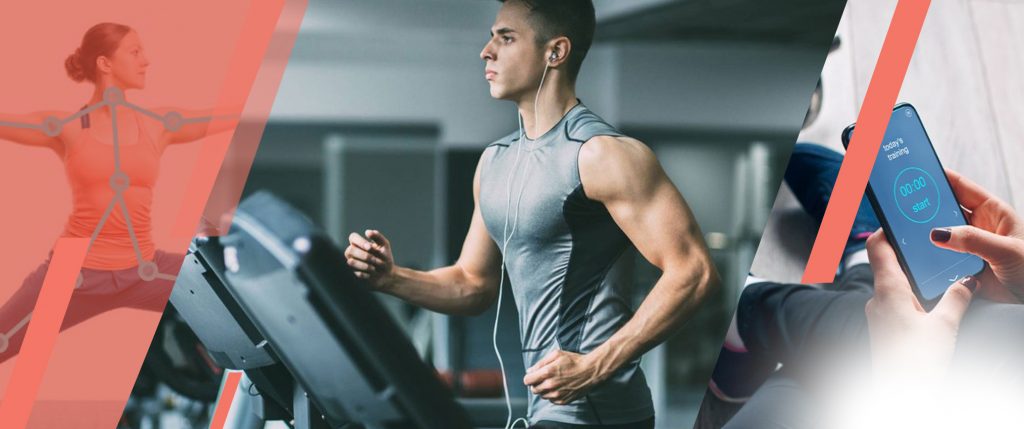
AI Fitness mobile app is a trend as more people are becoming health conscious amidst this pandemic age. Hence the fitness industry grows by 8.7% each year, and customized fitness app act as a stimulant in this growth. Feature-rich AI fitness app drives digital transformation in the business industry and also provides personalized services based on artificial intelligence development.
Human pose estimation is one of those major benefits of Artificial Intelligence in fitness app development. Technology is used to detect as well as process human posture. The center part of this technology is Human body modeling.
With the human pose estimation concept, fitness mobile apps can become much interactive as well as convenient
How Pose Estimation Works in AI Powdered Fitness Apps?
An AI-powered fitness app can be useful for users to practice physical exercises in a personalized and organized manner. A pose estimation algorithm receives an image of the user as input and shows the matches of certain key points or landmarks on the body. It contains two important parts, a convolutional encoder and a decoder. Fitness is a trend and AI based fitness apps are emerging.
AI-based fitness mobile app can be used efficiently through devices provided with a camera.
With regard to human pose estimation in a fitness app, the common algorithm follows four steps-
When the user begins the fitness app, the camera catches their movements during the exercise performance and records the video
In this step, the video is splitter into individual frames
Artificial intelligence analyzes the exercise pattern or technique and displays them
The app user can receive the description of mistakes along with the recommendations to fix them.
These four steps may seem simple. But developing such an AI fitness app, a fitness app development company faces many challenges and risks.
Top challenges and risks in human pose estimation fitness apps
Indeed, a single fitness app cannot answer all the questions. AI Fitness app development services attempt for meeting all the issues and challenges. Human pose estimation in AI-powered fitness apps come across the most important challenge in squatting exercising. Squatting is the basic exercise for athletes. Though it looks simple at first, it is very difficult to perform without the help of an individual trainer. The weight of the barbell makes this exercise hard even for athletes. Let’s assume that a personal trainer is replaced with human pose estimation in AI-powered fitness apps.
Body Specifies for Both Women and Men
While the training to human pose estimation models, it is essential to think about the physiological difference between the women’s and men’s bodies. In case the models got training on men’s images only, it will produce perfect results for only male users. As the difference in body postures for both men and women during physical exercise is huge, the model may fail to output accurate results even if the exercise was correctly performed.
Frontal View Error
The accurate technique to estimate the correctness of performance is to compare the movement of two people. So, the data is taken from input or user’s video that utilizes an AI-powered fitness app or the reference video that shows the correct exercise technique. It is vital to identify the position of 3D key points on both videos and align them to compare the user’s joints with the joints of an athlete from the reference video.
Different Specifies of Physiology
No human body has perfect proportions. Whether it is the length of arms, legs, or torso, everyone has some differences and disproportionalities. The focus of AI-powered fitness app development should be on creating the human pose estimation model. Those are capable of analyzing the user’s body properly. If a user has unusual body features like the non-standard length of arms, the accuracy will be low. This is when the human pose model fails to recognize this disproportionality of the user.
The Lack of Accuracy
Some pose estimation algorithms that execute the 2D detections don’t have sufficient accuracy for fitness apps. When the app is expected to be on mobile devices we can see that detections cannot keep up with human movements. It may provide poor results when running it in a fitness app from a mobile device.
Occluded Joints
There are particular exercises where body parts are occluded with other body parts or objects. Snatching is one such exercise. When the barbell overshadows the position of hands, the 2D detector locates key points in the wrong location. Thereby, the output of the 3D pose estimation model is wrong.
Quick Movements of the Lower Body Parts
When a person does a quick kick with the leg, the deep learning model might not grab this movement. The fast transition of the leg can be the reason, which can be occurred by the blurring of leg key points.
Conclusion
Artificial intelligence in fitness apps brings revolutionary changes. Therefore, the 3D pose estimation requires more effort to make more realistic human pose estimation models. In the upcoming years, business transformation services, as well as AI app development companies, will have more diverse data to provide human pose models with proper training.
Allianze Infosoft is one of the renowned fitness app development service providers that develop feature-rich fitness apps. Our business transformation services can address all the challenges. The in-house team of experienced developers strives to build user-friendly apps with excellent functionality. Drop us a mail at info@allianzeinfosoft.com
